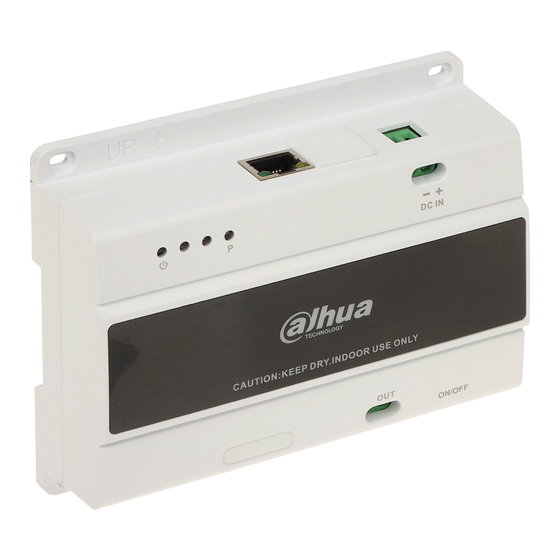
Table of Contents
Advertisement
Quick Links
Advertisement
Table of Contents

Summary of Contents for Dahua DHI-VTNS1001B-2
- Page 1 2-wire Switch User’s manual V1.0.0...
- Page 2 Foreword General This manual introduces the structure and installation of the 2-wire switch (hereinafter referred to as the "switch"). Safety Instructions The following categorized signal words with defined meaning might appear in the manual. Signal Words Meaning Indicates a high potential hazard which, if not avoided, will result in DANGER death or serious injury.
- Page 3 using the device. If there is any uncertainty or controversy, we reserve the right of final explanation. ...
-
Page 4: Important Safeguards And Warnings
Important Safeguards and Warnings This section introduces content covering the proper handling of the Device, hazard prevention, and prevention of property damage. Read carefully before using the Device, comply with the guidelines when using it, and keep the manual safe for future reference. Operation Requirements Change the default password after the switch is armed. -
Page 5: Table Of Contents
Table of Contents Foreword ................................I Important Safeguards and Warnings ......................III 1 Introduction ..............................1 Product Overview ..................................1 Application ....................................1 Cable Requirements .................................. 1 2 Structure ................................ 3 Front Panel ....................................3 Rear Panel ..................................... 4 3 Installation ..............................5 Installing with Screws ................................ -
Page 6: Introduction
Introduction Product Overview The switch provides one 2-wire P port and one RJ-45 port. You can connect up to 22 devices into the network with one switch. When connected to network through the switch, 2-wire indoor monitors (VTH) can make calls, unlock doors and monitor. Application A single 2-wire switch can connect at most 20 VTHs and 2 door stations (VTOs). - Page 7 Table 1-1 Description of using different cables Supported Device Cable Type for Cascading Maximum Distance Quantity 2-core cable 50 m between one switch and one VTH/VTO. 20 VTHs and 2 VTOs. 4-core cable 30 m between one switch and one VTH/VTO. Because each core in an Ethernet cable has a Ethernet cable 12 VTHs and 2 VTOs.
-
Page 8: Structure
Structure Front Panel Figure 2-1 Front panel structure Table 2-1 Structure description Item Description From left to right: POWER. Red: Powered on. Off: No power. Indicator Green flashes: Received PLC signal that either the VTH or VTO that is ... -
Page 9: Rear Panel
Rear Panel Figure 2-2 Rear panel structure Table 2-2 Structure description Item Description Use four ST3 × 18-SUS to install the switch. See "3.1 Installing with Screw holes Screws". Rail Use a guide rail to install the switch. See "3.2 Installing with Guide Rail". Lower hook Fix the switch when installing with a guide rail. -
Page 10: Installation
Installation The chapter introduces how to install the switch on the wall with screws or a guide rail. Installing with Screws Use screws to fix the switch at a proper location on the wall. Install the switch with screws Installing with a Guide Rail Preparation Prepare a standard 35 mm guide rail. - Page 11 Install with a guide rail (1) Fix the upper hooks inside the slot of the guide rail. Pull down the lower hook and press the switch close to the guide rail. Let go of the lower hook. Install with a guide rail (2)
-
Page 12: Cybersecurity Recommendations
Cybersecurity Recommendations Cybersecurity is more than just a buzzword: it’s something that pertains to every device that is connected to the internet. IP video surveillance is not immune to cyber risks, but taking basic steps toward protecting and strengthening networks and networked appliances will make them less susceptible to attacks. - Page 13 Disable Unnecessary Services and Choose Secure Modes If not needed, it is recommended to turn off some services such as SNMP, SMTP, UPnP, etc., to reduce risks. If necessary, it is highly recommended that you use safe modes, including but not limited to the following services: SNMP: Choose SNMP v3, and set up strong encryption passwords and authentication ...















Need help?
Do you have a question about the DHI-VTNS1001B-2 and is the answer not in the manual?
Questions and answers